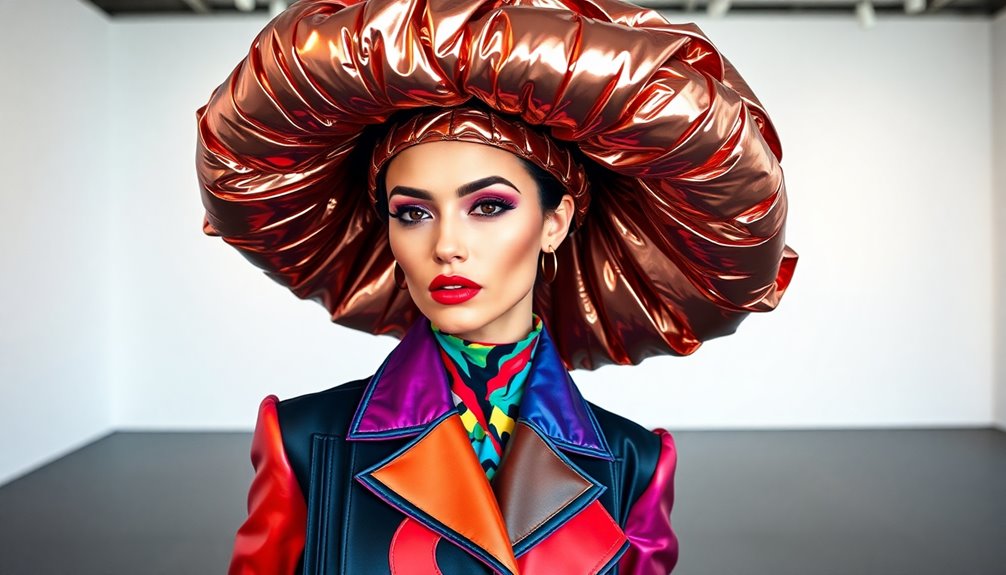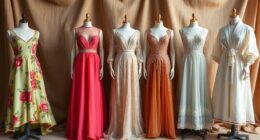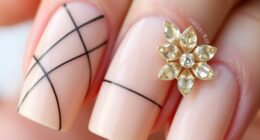Throughout history, fashion's shocking statements have stunned the world. You've probably heard of toxic materials like arsenic dye and lead-based makeup, which wreaked havoc on health. Dangerous accessories, like crinolines and corsets, posed serious risks, even leading to fatalities. Iconic outfits, such as Lady Gaga's meat dress, sparked debates on activism and societal norms. The cultural impact of these bold choices reflects deeper social issues. Luckily, awareness has grown, prompting better safety standards. There's so much more about these memorable fashion moments that's just waiting to be explored. You won't want to miss what comes next!
Key Takeaways
- Josephine Baker's banana skirt in the 1920s challenged racial stereotypes and showcased the power of fashion as a political statement.
- Lady Gaga's meat dress at the 2010 MTV Video Music Awards sparked controversy and discussions on animal rights activism.
- The swan dress worn by Björk at the 2001 Academy Awards defied traditional beauty norms and promoted artistic expression in fashion.
- Karlie Kloss's Native American headdress at a fashion show raised awareness about cultural appropriation and the complexities of fashion identity.
- The rise of activist fashion, such as slogan tees, reflects current social movements and the role of fashion in addressing global issues.
Toxic Fashion Materials
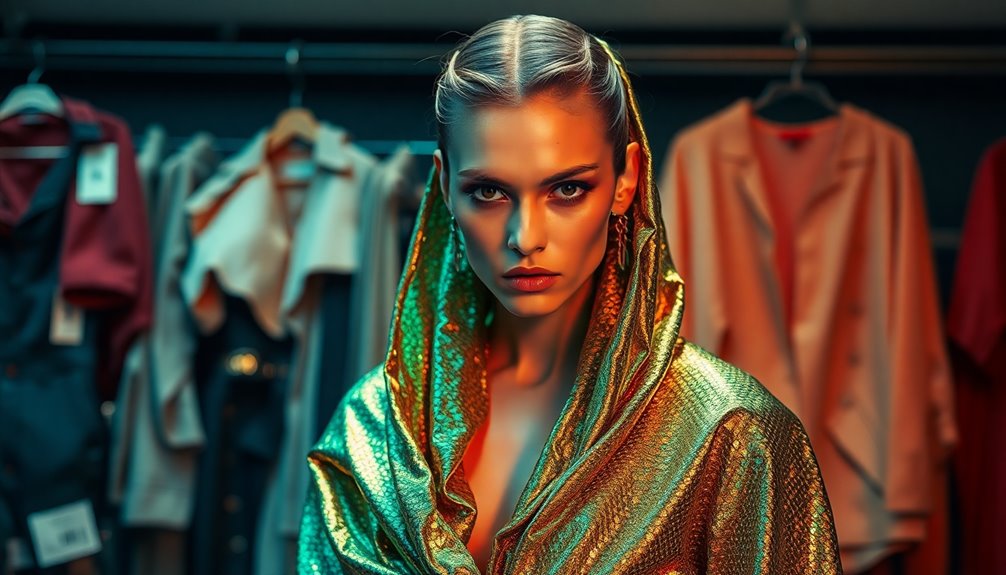
While fashion often reflects beauty and elegance, it's vital to recognize the hidden dangers lurking in some materials. Throughout history, toxic substances have been woven into the fabric of style, leading to severe health issues.
For instance, the vibrant green arsenic dye introduced in the 19th century caused skin lesions and organ failure, prompting regulations by 1895. Similarly, Venetian ceruse, a lead-based skin whitener, resulted in cognitive decline and the grim moniker "Death by Vanity."
Lead-based makeup was also notorious, with users experiencing symptoms of lead poisoning, like seizures. Radium-laced cosmetics, marketed for their beauty benefits, ultimately led to cancer diagnoses, showcasing the risks associated with these hazardous materials. Additionally, many individuals may not realize that some essential oils for health can also pose risks if misused, highlighting the importance of understanding what you put on your skin.
It's vital to understand what you put on your skin.
Dangerous Accessories and Their Risks
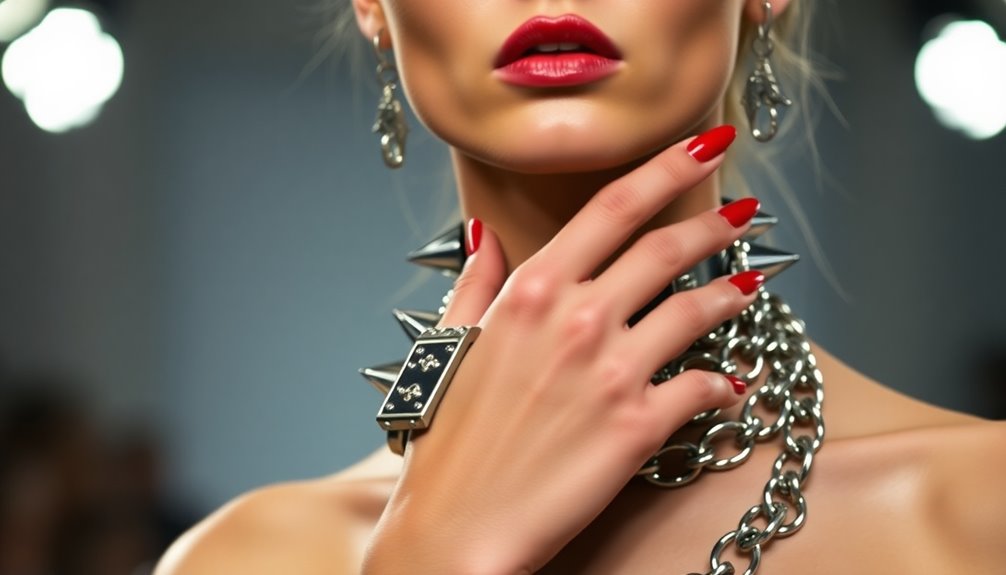
Fashion isn't just about the clothes we wear; it also encompasses the accessories that complete our look. Some of these accessories can be surprisingly dangerous. High heels, for instance, pose significant health risks, leading to foot deformities and an increased likelihood of falls. Crinolines, made of flammable materials, resulted in fire hazards that claimed around 630 lives annually.
Here's a quick look at some dangerous accessories:
| Accessory | Risks |
|---|---|
| Crinolines | Fire hazards |
| High Heels | Foot deformities, chronic pain |
Health Hazards of Beauty Trends

When you think about beauty trends throughout history, it's shocking to see how many came with serious health risks.
From toxic ingredients in cosmetics to dangerous fashion accessories, many styles have had dire consequences.
It's a stark reminder that looking good often came at a hefty price.
Toxic Ingredients in Cosmetics
Throughout history, beauty trends have often masked dangerous ingredients lurking in cosmetics. You might be surprised to learn that arsenic dyes, used in 19th-century green dresses, caused severe health issues like skin lesions and organ failure, prompting regulatory changes by 1895.
Similarly, Venetian ceruse, a lead-based skin whitener from the 16th century, led to cognitive decline and serious skin damage. In the early 20th century, radium-laced cosmetics marketed for their beauty benefits resulted in cancer and radiation sickness, triggering regulatory actions in the 1920s.
Even mercury-treated hats, linked to "mad hatters," caused mercury poisoning with debilitating symptoms. These shocking examples remind us to be cautious about toxic ingredients in cosmetics and their potential health risks.
Dangerous Fashion Accessories
Toxic ingredients in cosmetics aren't the only hidden dangers in the world of beauty. Fashion statements have often come with serious health risks. From corsets to crinolines, some accessories have caused more harm than good.
| Accessory | Health Risks | Historical Context |
|---|---|---|
| Corsets | Organ displacement, fainting | 16th-19th centuries |
| High Heels | Chronic pain, foot deformities | Since the 16th century |
| Crinolines | Fire hazards (flame contact) | 19th century |
| Chopines | Balance issues, dependency on help | Venetian fashion |
| Mercury Hats | Mercury poisoning | 18th-19th centuries |
Next time you put on a fashionable accessory, consider the potential dangers lurking beneath the surface!
Fatalities Linked to Fashion Choices
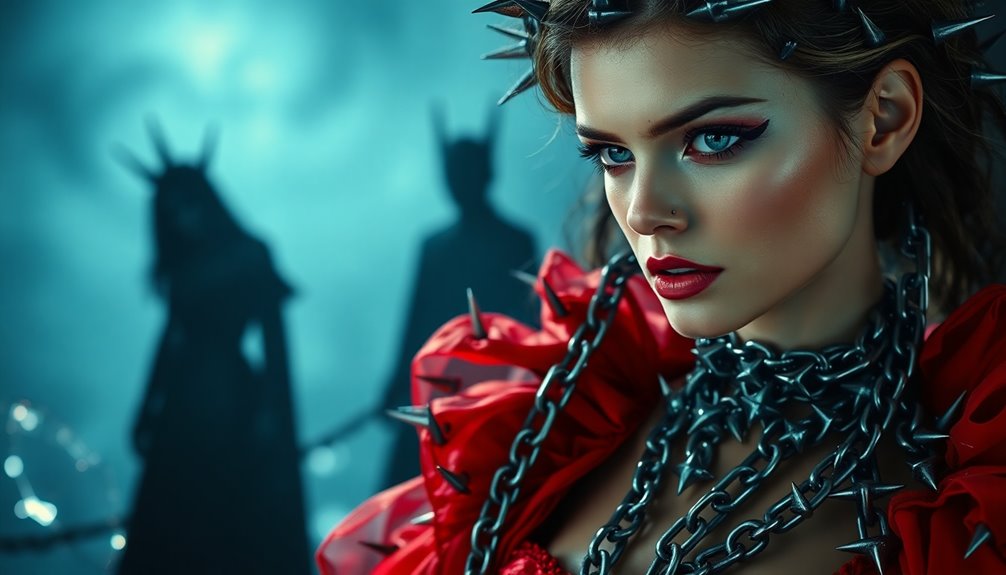
Fashion has often danced a delicate line between beauty and danger, with certain trends posing serious risks to health and safety.
Corsets, for instance, were notorious from the 16th to 19th centuries for causing organ displacement and fainting, with fatalities linked to fashion choices due to restricted breathing.
Crinolines, while stylish, were highly flammable, leading to an estimated 630 deaths annually in fire-related incidents.
The infamous "father killers," Edwardian collars, resulted in asphyxiation deaths, like that of John Cruetzi in 1888.
Hobble skirts, worn between 1908 and 1914, restricted mobility, causing numerous accidents and fatalities as women struggled to walk.
Ultimately, mercury used in hat-making led to "mad hatter" syndrome, with some tragic fatalities due to prolonged exposure.
Cultural Impact of Fashion Statements
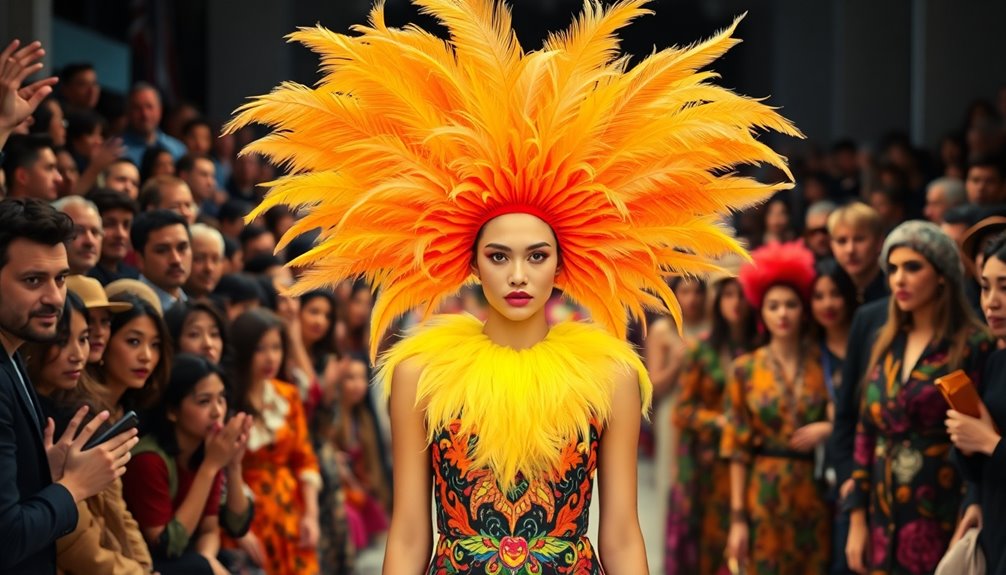
Fashion doesn't just cover your body; it shapes your identity and reveals your place in social hierarchies.
You can see how bold choices challenge conformity and express rebellion, reflecting deep cultural shifts.
Think about how iconic outfits have sparked conversations about race, gender, and societal values throughout history.
Fashion and Social Hierarchies
While it might seem that clothing is simply a matter of personal choice, it often reveals deep-seated social hierarchies and cultural dynamics. Throughout history, fashion trends have illustrated how women's fashion can empower yet restrict.
For instance, Tudor ruffs signified aristocracy, while hobble skirts confined movement, reinforcing societal expectations. Similarly, Venetian chopines elevated women above the filth of the streets, highlighting class and gender divisions.
The Victorian corset exemplified the pressure on women to conform to an idealized figure, often sacrificing health. Additionally, instances of cultural appropriation, like Karlie Kloss's Native American headdress, show the complex interplay between fashion, identity, and social hierarchies. The concept of temperament in child development can also be observed in how individuals express themselves through fashion choices, reflecting their unique personality traits.
Ultimately, what you wear can reflect not just personal style, but also societal values and divisions.
Identity Through Clothing Choices
Clothing choices act as a canvas for self-expression, allowing individuals to showcase their identities and challenge societal norms. Fashion has always reflected cultural shifts, especially for women seeking empowerment.
Here are three iconic examples:
- Josephine Baker's banana skirt (1926) – This outfit critiqued traditional femininity, pushing boundaries and celebrating freedom.
- Coco Chanel's Little Black Dress (1926) – A symbol of women's independence, it transformed how society viewed modern femininity.
- Lady Gaga's meat dress (2010) – This controversial statement sparked dialogue about animal rights, highlighting fashion's role in political discourse.
These bold choices demonstrate how clothing can serve as a powerful medium for expressing diverse identities, ultimately reshaping societal perceptions and inspiring change.
Rebellion Against Conformity
When individuals don unconventional outfits, they often challenge societal norms and ignite conversations about identity and representation.
Women like Lady Gaga, with her infamous meat dress, and Josephine Baker, flaunting her banana skirt, use fashion as a rebellion against conformity. These bold choices spark discussions on race, sexuality, and societal expectations.
The Little Black Dress introduced by Coco Chanel transformed women's fashion, allowing them to break free from restrictive clothing that symbolized oppression.
Björk's swan dress at the 2001 Academy Awards further pushed boundaries, questioning conventional beauty standards.
Fashion shows featuring such daring statements encourage audiences to rethink their perceptions, making fashion not just a personal expression but a powerful tool for cultural change.
Evolution of Fashion Safety Standards

As society became increasingly aware of the health hazards associated with fashion materials, the evolution of safety standards gained momentum.
You might be surprised to learn how regulations around toxic materials have shaped what we wear today. Here are three key milestones:
- Arsenic Dyes: In the late 19th century, laws banned these toxic synthetic dyes after public health concerns emerged.
- Lead-Based Makeup: Awareness of its dangers led to a ban, influencing both fashion and beauty industries.
- Flammable Crinolines: The dangers of these garments spurred scrutiny that prompted regulations on materials used in women's fashion.
Today, regulatory bodies actively monitor hazardous materials, ensuring safer and more ethical practices in clothing design and production.
Public Perception and Awareness
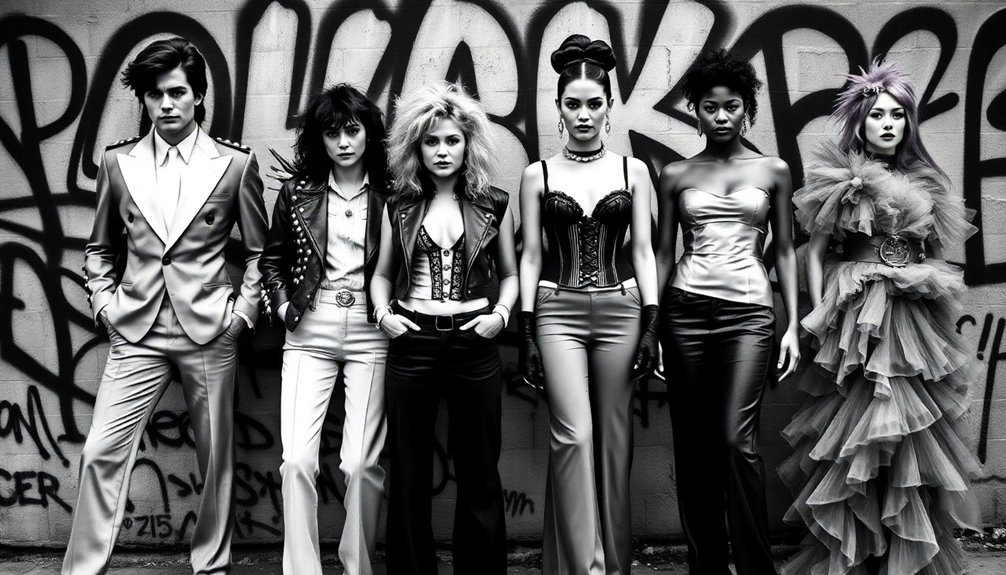
With safety standards now in place, the conversation around fashion has evolved to include public perception and awareness.
Today, shocking fashion statements often spark intense debates, shaped by societal norms and cultural sensitivities. You might recall the backlash against Gucci's wool balaclava jumper, which brought cultural appropriation and insensitivity to the forefront of fashion controversies.
Similarly, Lady Gaga's meat dress ignited discussions about animal rights, showcasing fashion's potential as activism.
Social media amplifies these conversations, allowing real-time public reactions that can drastically alter a brand's image.
Historical examples, like Josephine Baker's banana skirt, remind us that scandalous fashion choices can challenge norms and serve as powerful political commentary, highlighting fashion's role in reflecting and influencing public perception. Furthermore, the evolving nature of fashion often leads to the discussion of aesthetics that transcends mere trends, encouraging deeper engagement with cultural narratives.
Frequently Asked Questions
What Are 3 Interesting History Facts About Fashion?
When you plunge into fashion history, you'll uncover some fascinating facts.
For instance, the introduction of arsenic dyes in the 19th century led to serious health risks.
You might also learn about foot binding in China, which sought to achieve tiny feet but caused lasting deformities.
Moreover, corsets shaped women's bodies for centuries, but they often resulted in broken ribs and organ displacement, prompting health warnings by the 19th century.
What Is the Biggest Fashion Mistake?
You might argue that one of the biggest fashion mistakes is the use of lead-based makeup in the 18th and 19th centuries.
While it was seen as a beauty standard, it led to severe health issues like lead poisoning for many women.
Imagine prioritizing aesthetics over your well-being! This trend highlights how society often sacrifices safety for beauty, reminding you to always consider the consequences of your fashion choices.
What Is Controversial Fashion?
Controversial fashion often stirs debate and can impact public perception considerably; in fact, about 70% of consumers say they've changed their views based on fashion statements.
You'll find that controversial fashion challenges societal norms, provoking discussions about cultural sensitivity and identity.
Designers use bold statements to address pressing issues, like animal rights or cultural appropriation, prompting you to reconsider the messages behind the clothes you wear and the implications they carry.
What Historical Events Impacted Fashion?
Historical events have dramatically shaped fashion trends over the centuries.
You'll see how the French Revolution shifted styles toward simplicity, while the Industrial Revolution made clothing more accessible through mass production.
World War I changed women's roles, leading to practical styles like shorter skirts.
The Roaring Twenties embraced flapper dresses as symbols of liberation, and the Civil Rights Movement celebrated cultural identity through bold patterns and styles.
Each event influenced how you express yourself through fashion.
Conclusion
In the wild world of fashion, you're not just wearing clothes; you're flirting with danger! Who knew that those jaw-dropping stilettos could lead to a twisted ankle or that bold lipstick might harbor toxic secrets? It's a thrilling ride through the catwalk of chaos! So, as you strut your stuff, remember: style can be a double-edged sword. Stay savvy and sassy, and let your fashion choices shout, "I'm fabulous, but I'm not a walking health hazard!"

